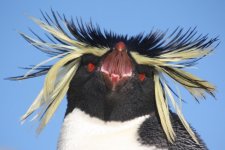
Not sure if this has been mentioned already on BirdForum Taxonomy but it was recently posted on Birding-Aus.
Tom
Tony Pym <[email protected]> wrote:
A paper in the journal Molecular Ecology by Pierre Jouventin et al has shown, as expected, that the Rockhopper Penguin should be split and recognised as two species, E. chrysocome and Eudyptes moseleyi .
For information, here's an abstract:
The taxonomic status of populations of rockhopper penguins (Eudyptes chrysocome) is still enigmatic. Northern populations differ from southern ones in breeding phenology, song characteristics and head ornaments used as mating signals. We conducted a molecular analysis using mitochondrial DNA sequencing to test if there is a gene flow barrier between northern (subtropical) populations and southern (subantarctic) populations in relation to the Subtropical Convergence, a major ecological boundary for marine organisms. Sequences of the control region and the ND2 gene were analysed in rockhopper penguins and in the macaroni penguin (Eudyptes chrysolophus), a closely related species. Genetic distances and phylogenetic analyses showed a clear split into three clades, two rockhopper clades and the macaroni penguin. Moreover, ÈST and gene flow estimates also suggested genetic structuring within the northern rockhoppers. Our results add further support to the notion that the two
rockhopper penguin taxa, often considered as two subspecies, can be recognized as two species E. chrysocome and E. moseleyi. The divergence in mating signals found between these two taxa seems to have occurred recently and relatively rapidly. Thus, the behavioural changes may have been enough to isolate these taxa without the need for morphological differentiation. The findings have important conservational implications, since E. moseleyi is far less abundant than E. chrysocome, but more populations may warrant an uplisting to endangered status if full species status should be recognized for more subpopulations.
Tom
Tony Pym <[email protected]> wrote:
A paper in the journal Molecular Ecology by Pierre Jouventin et al has shown, as expected, that the Rockhopper Penguin should be split and recognised as two species, E. chrysocome and Eudyptes moseleyi .
For information, here's an abstract:
The taxonomic status of populations of rockhopper penguins (Eudyptes chrysocome) is still enigmatic. Northern populations differ from southern ones in breeding phenology, song characteristics and head ornaments used as mating signals. We conducted a molecular analysis using mitochondrial DNA sequencing to test if there is a gene flow barrier between northern (subtropical) populations and southern (subantarctic) populations in relation to the Subtropical Convergence, a major ecological boundary for marine organisms. Sequences of the control region and the ND2 gene were analysed in rockhopper penguins and in the macaroni penguin (Eudyptes chrysolophus), a closely related species. Genetic distances and phylogenetic analyses showed a clear split into three clades, two rockhopper clades and the macaroni penguin. Moreover, ÈST and gene flow estimates also suggested genetic structuring within the northern rockhoppers. Our results add further support to the notion that the two
rockhopper penguin taxa, often considered as two subspecies, can be recognized as two species E. chrysocome and E. moseleyi. The divergence in mating signals found between these two taxa seems to have occurred recently and relatively rapidly. Thus, the behavioural changes may have been enough to isolate these taxa without the need for morphological differentiation. The findings have important conservational implications, since E. moseleyi is far less abundant than E. chrysocome, but more populations may warrant an uplisting to endangered status if full species status should be recognized for more subpopulations.








